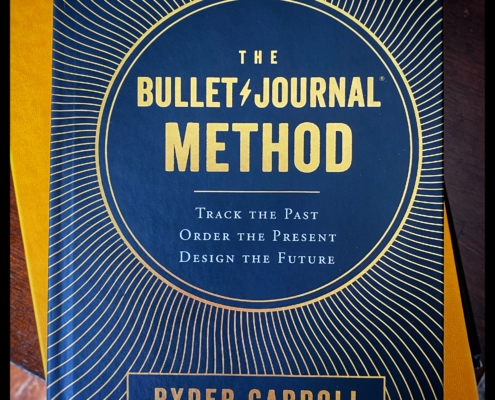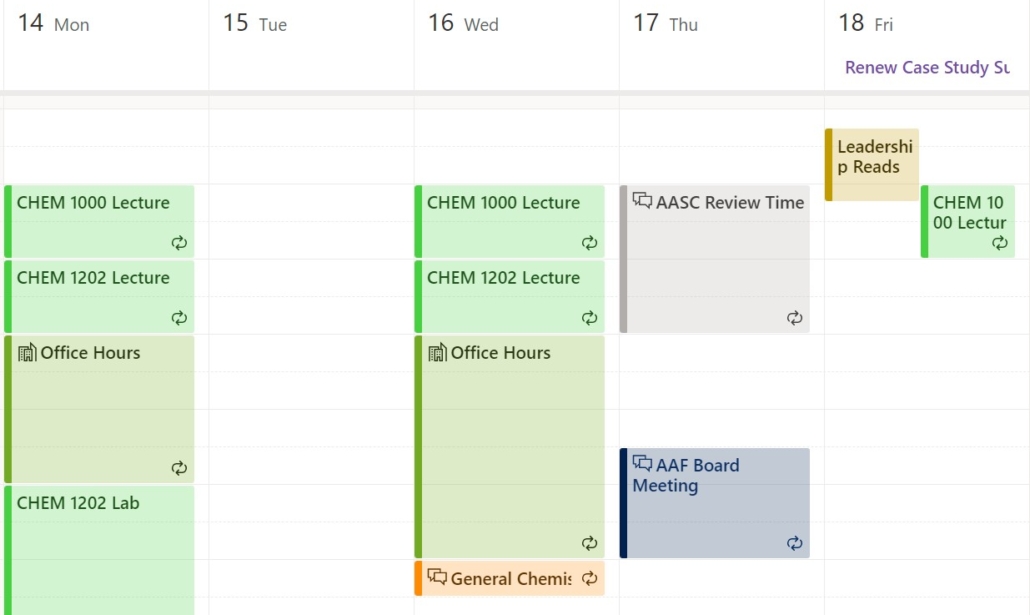Below are some tips, tricks, and tools to help students develop an organizational and planning system that works for them. Click on the tabs below to review this information.
Organization and Planning Tips and Tools for Students
Step 1: Find a Calendar
This can be a digital calendar such as Outlook or Google Calendar or a paper planner you can get from your local box store or order online. All MinnState students have access to Outlook. Use your StarID and password to access. Google Calendar and Outlook Apps are available through the Google Play and Apple apps stores. The most important part of what you use is that it works for you.
Figure 1.0 and 2.0 discuss how to use Google Calendar and Outlook to stay organized and manage your time.
Figure 1.0 – How to Use Gmail, Keep Notes, Google Calendar Together to stay organized.
Figure 2.0 – Using the Microsoft Outlook Calendar to manage your time.
A few paper planner options are linked below:
The Lot Planner – designed by a graduate student for students. There are sections for project planning, monthly and weekly calendar pages, goal-setting areas, and weekly review space.
A basic weekly planner is sometimes given out by high schools and some colleges for students and is available at most box stores or college bookstores. The link provided HERE gives an example of this type of planner. They are inexpensive and can be used to record assignments and project due dates. They are great for breaking out projects into smaller pieces and scheduling completion dates for each part.
Bullet Journal – This is a very personalized system of organization. It can be minimal or complicated as you desire. The idea is to track projects, due dates, and ideas in one place. Any lined, dotted, or grid notebook can be used as a bullet journal. A video on how to bullet journal can be found HERE.
There are many more digital and paper planner systems than this available. I encourage you to take the time to research other options available to find the best fit for you.

The Bullet Journal Method (book) by Ryder Carroll.
Step 2: Schedule Your Time
Put ALL of your classes, work hours, and other life obligations into your calendar. Schedule study time for each of your classes (it is recommended you schedule 2-3 hours minimum study time outside of class for each credit a course is worth). This will give you an idea of what kind of time commitments you have made in your life.
You may also want to schedule your sleep (7-8 hours) and meals (~30 minutes each) in as well so you meet those needs too. You need to fuel yourself so you can be your best. Don’t skip those needs.
An example of scheduling your day using Outlook. This allows you to see the space you have in your day to complete homework and address other responsibilities.

NOTE: If you can’t schedule all of your family responsibilities, extracurricular activities, work hours, classes, and study hours in your day and allow yourself a reasonable amount of time to eat and sleep each day, then you are probably overscheduled/overextended and should reduce some of your commitments. Your grades are more likely to suffer when you are overcommitted. Set yourself up to succeed and don’t overcommit yourself.
The video provided below, produced by The University of Buffalo, talks more about time management and how to schedule your time.
Step 3: Organize To-Dos
When you find out about an assignment, project, exam, etc, mark the due date in your planner. If your instructor gives you a semester schedule outlining when things are due, take time to sit down and add all of those due dates to your planner. This keeps all information about your classes in one place so it’s easier to track and organize.
When you have a big project, break down projects into smaller pieces and schedule time for yourself to complete those tasks. For example, if you have a lab report due in your chemistry class, you might break the assignment down into the following tasks:
1. Organize the experimental information into the report sections.
2. Setup the file and format the report.
3. Write the introduction and experimental procedure.
4. Create the data tables and write the results and discussion sections.
6. Write the conclusion section and list my references.
7. Proofread and submit the report.
Breaking larger projects and assignments into smaller tasks will make it easier to schedule time to complete projects and make them more manageable to complete. This strategy also allows you to take advantage of smaller increments of time throughout the day, such as 30-minute or 1-hour breaks between classes, to complete assignments. You would be amazed at how quickly a large project can be completed when you break it into manageable chunks.
Procrastination is the enemy of successfully completing assignments and preparing for exams. You can organize and plan to your heart’s content, but it won’t help you achieve your goals unless you follow your plan. The video below, created by Crash Course, talks about procrastination, our motives for procrastinating, and how to successfully overcome this sneaky foe.
The following videos discuss using the To Do feature in Outlook (top video) and Google Keep (bottom video) to organize and track tasks.
Step 4: Review Weekly
Schedule time each week to sit down and review what is coming due, add any new assignments to your planner, and plan to meet those due dates. To start, plan at least 30 minutes each week for this time. You may discover that you need more or less time for review and planning as you practice this habit. Look a few weeks ahead so you know when larger projects are coming due so you can break them into smaller pieces. This will prevent unexpected surprises and the stress that comes with realizing you have a large project due and didn’t allow time to complete it.
If you are new to time management and planning, this will take time to master. This video created by Crash Course talks about time management and how to build those soft skills for life.
Step 5: Experiment to Find What Works Best.
Give yourself time to find something that works for you and develop the habits and routines that maintain it and support you. This is not an easy skill to develop for some people. Be patient with yourself. The planning system I used in college is not the same system I use today. These systems will need to adjust as your life changes; however, the more you practice this habit, the easier it will be to adjust to meet the needs of your life. Again, the most important thing is that you find a system that works for you, whatever that may be.
Some ideas to get you started:
- Keep your schedule in a digital calendar and track your to-do/track due dates in a paper planner.
- Keep your schedule and due dates in a digital calendar. The two videos provided here illustrate how to do this.
- Track everything in a paper planner.
- Create a bullet journal using a simple, inexpensive notebook.
- Keep your schedule in a digital calendar and track your to-do/track due dates/projects in a bullet journal.
- Use a combination of a digital task tracker and a digital calendar to track projects/assignments/due dates.
Keep your schedule and due dates in a digital calendar. The two videos provided below illustrate how to do this.
This video is also a great example of planning your todos for the day and balancing it with your calendar.
This page was published on February 19, 2023 and last updated on August 3, 2023.
©2023 Catherine Haslag. All Rights Reserved.

